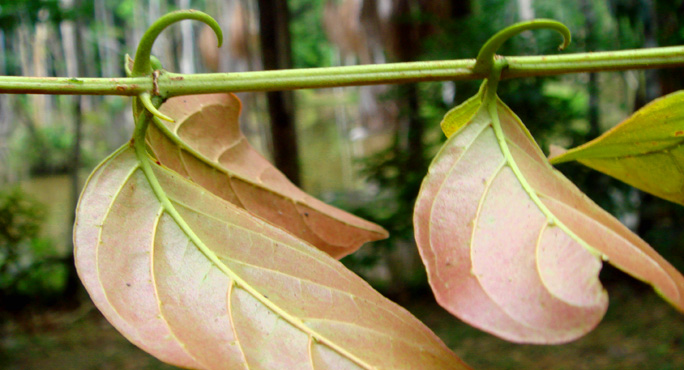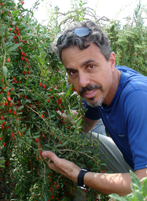
Cat's Claw, Peruvian Amazon. Photo by Zoe Helene
 “You need to understand plant chemistry, be inured to discomfort and awesomely flexible. When something breaks down—the plane, the boat, you just have to roll with it.” - Chris Kilham
“You need to understand plant chemistry, be inured to discomfort and awesomely flexible. When something breaks down—the plane, the boat, you just have to roll with it.” - Chris KilhamEthnobotanist Chris Kilham travels to far-flung corners of the world in search of nature’s most powerful remedies
Known as the “kava guy” for his role in bringing the powerful stress-relieving plant to the mainstream, ethnobotanist Chris Kilham has also been called the Indiana Jones of herbal medicine.
A member of Medical Advisory Board of The Dr. Oz Show, the Fox News Medicine Hunter, and Explorer in Residence at Naturex of Avignon and the University of Massachusetts at Amherst, Kilham has no advanced degrees of his own, but he does have more field experience than most. He travels to the Peruvian Amazon six times each year, and if you ask him what to put on a scorpion sting to relieve the pain, he’ll tell you. When we spoke, he had just returned from New Zealand and was preparing to head out on an expedition to a remote village in Vanatu.
Kilham spends at least 60 percent of his time on the road. He conducts research to advise companies about investing in plants that have potential to benefit us medicinally, in supplements and skincare, and can be sourced ethically and sustainably while helping local indigenous communities around the world. Kilham wants Westerners to benefit from the powerful plant medicine that indigenous peoples have relied on for thousands of years.
A trip to El Yunque rain forest in his teens fostered a strong desire to travel along with an interest in herbs. “I remember thinking, I want to go to cool places like this and study plants,” he says. Soon after, Kilham, an avid yogi, took ill on a trip to an Indian ashram and was cured by an ayurvedic herbal doctor in Katmandu. ”That really galvanized my sense that herbs were actual medicine.”
What does it take to be a medicine hunter? “You need to understand plant chemistry, be inured to discomfort and awesomely flexible. When something breaks down—the plane, the boat, you just have to roll with it.”
CHRIS KILHAM'S TOP 10 BEAUTY BOTANICALS
1: Cocoa Pod Solids
What it is: The extract from the cocoa plant pod
What it does: “The cosmetic industry has long used cocoa butter (fat) in creams, but the treasure is in the solids, with profound anti-aging benefits for skin. It has the highest antioxidant value of anything on earth, and also helps reduce the risk of heart attack, stroke, type 2 diabetes, and cancer, according to research from the Harvard University Medical Center.”
2: Manuka Oil
What it is: It’s not manuka honey, though manuka oil is also from New Zealand. It’s extracted from the leaves and branches of the manuka tree.
What it does: “Manuka is 15 times more powerful than tea tree oil, with a more pleasant aroma. It is everything tea tree oil wants to be. It’s antibacterial, antioxidant, and, in addition to the healing benefits, it may also play a role as a preservative.”
3: Rosemary
What it is: A hearty herb that grows in the United States and Europe
What it does: “Nothing else works as well to make hair lustrous and improve the health of the hair follicles. The rosmarinic acid in rosemary is an antioxidant preservative, used in meats, yogurt and cosmetics.”
4: Hawthorn
What it is: A plant grown in Morocco
What it does: “Primarily used for heart health, it enhances the heart muscle.” But it also has a powerful effect on the skin. “Taken internally and topically, it rapidly increases the function of new collagen. Hawthorn is going to have its day as a significant cosmetic ingredient.”
5: Maca
What it is: A root vegetable, native to the Peruvian Highlands
What it does: Known as “Peruvian ginseng,” it improves energy, stamina and libido, and reduces the risk of prostate cancer, according to the Journal Reproductive Biology and Endocrinology. The root is dried and made into a powder that can be added to baked goods, smoothies and supplements.
6: Dragon’s Blood
What it is: The latex from a tree in the Amazon. You score the tree with a blade to access the dragon’s blood.
What it does: “If you apply it straight, it forms a kind of latex bandage on the skin and it will kill infections and help skin heal quickly. It heals cuts, burns, bites and abrasions, and stimulates collagen.”
7: Tamanu Oil
What it is: The oil extracted from the nut of the tropical tamanu tree, found in Hawaii, Micronesia and Tahiti
What it does: “It is the single most beneficial skin-healing agent—period. It’s an entire pharmacy for the skin. It heals cuts, burns, rough spots. It is antiaging, antibacterial, antiacne, and gets rid of herpes and shingles. The only thing it won’t help: eczema and psoriasis.”
8: Witch Hazel
What it is From the bark of the witch hazel shrub native to North America
What it does: “It is an astringent and it tightens, tones and cleanses the skin. It is ideal as a facial mister, or to splash on the face after shaving.”
9: Rhodiola
What it is: A root from Siberia and China
What it does: “The best antidepressant out there, with spectacular benefits for energy, stamina, endurance, mental clarity and libido. It is also a powerful antioxidant, and helps prevent oxidation of the lipid membrane to keep skin healthy.”
10: Cat’s Claw
What it is: The interior bark of a vine from the Amazon.
What it does: “It repairs skin by stimulating collagen. It’s not really showing up in the U.S., yet, but it’s coming. In South America, it’s in practically every balm.”
For a list of products we like, please see our Skin, Hair & Nail Support page.

